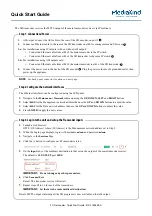
SECTION D
OUTPUT NETWORK
D.1.
Principles of Operation
The Output Network is a Butterworth
bandpass filter which passes the carrier fre-
quency but attenuates all harmonics, and a
TEE section which matches to a range of
impedances on the transmitter output termi-
nal.
The bandpass filter consists of a series
resonant LC section (L1-C1), a parallel
resonant tank circuit (L2-C2), series capaci-
tor C3, and a portion of the Tuning coil.
In addition to being part of the bandpass
filter, the L1 and L2 coils provide adjust-
ments which are used in the factory setup
for matching the PA output to the network.
The PA combining impedance, as measured
looking into the network is roughly 7 ohms
per PA module, and a slightly negative re-
actance depending on carrier frequency.
The TEE matching network, which the
Tuning and Loading controls are part of, is
designed with a 45 degree phase shift. This
results in minimal interaction between the
two controls.
The normal input and output impedance
for the TEE network is 50 ohms. However,
the TEE network is designed with the capa-
bility to match an output impedance of up
to a 1.5:1 VSWR. This allows the PA mod-
ule(s) to be tuned to the most desirable
impedance, given a range of output load
impedances.
The shunt leg of the TEE network func-
tions as a third harmonic trap as well as
being a part of the impedance matching.
D.2.
Adjustment Procedures
D.2.1.
Tuning And Loading Controls
The Tuning and Loading controls are ba-
sically to be adjusted for a null in the VSWR
Detector Null reading on the multimeter.
This adjustment achieves 50 ohm j0 at a
certain point in the Output Network.
However, it should also be recognized that
it is possible at many frequencies to have a
setting of the Tuning and Loading controls
which result in obtaining the wrong 50 ohm
point. This wrong 50 ohm point would only
be found by changing the controls dramati-
cally from the factory setting.
The wrong 50 ohm point is one in which
a larger than normal portion of both the
Tuning and Loading controls is used. The
bandwidth of the network will be reduced,
and more stress will occur on the C4 capaci-
tor in the Output Network.
Finding the correct 50 ohm point is a
matter of initially setting both coils at mini-
mum inductance, which is with their taps at
the top of the coils.
As the coils are then adjusted downward
for 50 ohms (whether by impedance meas-
urement or by nulling the VSWR Detector
reading), the first setting where 50 ohms is
achieved is the correct setting.
D.2.2.
Output Network Cold Tuning
The Output Network will not likely re-
quire complete adjustment unless you
change frequency. The information is in-
cluded here for that purpose, or for checking
of its alignment if there are concerns about
its adjustment.
WARNING
ENSURE ALL VOLTAGE HAS BEEN RE-
MOVED FROM TRANSMITTER AND
G RO U N D I N G S T I C K I S U S E D TO
GROUND ALL POINTS WHERE AC OR RF
POWER HAS BEEN APPLIED BEFORE
PROCEEDING.
The following paragraphs describe a cold
tuning procedure for the Output Network.
All voltage must be removed from the trans-
mitter in order to cold tune the Output Net-
work. Tuning the Output Network should
not be attempted in the presence of an RF
field on or near the frequency of the trans-
mitter. For example, the procedure for set
up cannot be used while a standby transmit-
ter is on. The presence of an RF field on the
same or adjacent frequency will severally
impair achieving proper adjustment.
D.2.2.1.
Third Harmonic Trap L7-C4
Disconnect from the TUNING coil
(A21L4) the strap which goes to A21L7, the
third harmonic coil. This will separate the
third harmonic trap circuit from the rest of
the Output Network.
Adjust L7 for resonance (minimum im-
pedance) at the third harmonic of the carrier
frequency. This may be accomplished with
an RF bridge, vector impedance meter, or
any suitable impedance measuring device
connected between L7 and ground near
A21C4.
Resonance may also be determined with a
variable RF generator when used with an
oscilloscope and a resistor. Put a 10k ohm
resistor in series with the RF signal going
to the trap circuit. Connect the oscilloscope
with a low capacitive probe to the trap coil.
Resonance occurs at the frequency where
the amplitude on the oscilloscope is mini-
mum.
D.2.2.2.
Bandpass Filter L2-C2
Disconnect the strap which connects to
the input side (towards rear of transmitter)
of A21 C3.
Disconnect the strap which connects to
the feedthrough bolt on the enclosure con-
taining A21L1 and A21C1.
Connect an RF bridge, vector impedance
meter, or any suitable impedance measuring
device between the strap which was discon-
nected from A21 C3 and ground.
L2-C2 is set for resonance (maximum im-
pedance) at the carrier frequency. Adjust L2
by rotating the entire coil. It will be neces-
sary to loosen mounting hardware in order
to accomplish this.
CAUTION
THE RESONANT FREQUENCY OF L2-C2
MUST BE MEASURED ONLY WHEN THE
REAR PANEL IS INSTALLED. A FREQUENCY
SHIFT OF APPROXIMATELY 4 KHZ WILL BE
NOTED WHEN THE REAR PANEL IS OPEN.
Due to the close proximity of the rear
panel, it is necessary to have the rear panel
installed for reading the exact resonance of
L2-C2. L2-C2 should be set to resonance no
more than 2 kHz from carrier frequency.
At resonance the impedance of L2-C2 is
2500 ohms or more.
D.2.2.3.
TEE Network - Load and Tune
Reconnect L2-C2 to A21 C3. The strap to
the feedthrough bolt on the L1-C1 enclo-
sure should still be disconnected.
Connect the RF bridge to the bracket
(rear) end of A21 L2.
Before beginning the following adjust-
ment procedure, rotate the LOADING coil
and the TUNING coil to the right until both
stop. This should put the sliding taps of the
Tuning and Loading controls at the top of
their range. This should put the coils at
minimum inductance.
While monitoring the RF bridge, adjust
the LOADING and TUNING coils for 50
ohms j0 but do not adjust either coil more
than one complete turn without first adjust-
ing the other coil.
Reconnect the strap to the L1-C1 Feedthru
bolt. Disconnect PA module A1 from L1.
Connect an RF Bridge to L1 (where A1 was
disconnected) and ground.
NOTE
Refer to factory test data sheet for data
on the PA combining impedance.
D.2.2.4.
L2 Sliding Tap
The tap on L2 is set for the correct loading
of the PA module. The impedance that the
888-2314-001
D-1
WARNING: Disconnect primary power prior to servicing.
Содержание Gates Five 994 9204 002
Страница 4: ......
Страница 6: ...iv 888 2314 001 Rev X WARNING Disconnect primary power prior to servicing...
Страница 8: ...vi 888 2314 001 Rev X WARNING Disconnect primary power prior to servicing...
Страница 28: ...2 12 888 2314 001 Rev AC 2 29 00 WARNING Disconnect primary power prior to servicing...
Страница 40: ...Figure 5 1 PDM Flow Diagram 5 2 888 2314 001 Rev T Jan 1996 WARNING Disconnect primary power prior to servicing...
Страница 42: ...Figure 5 2 PDM Loop 5 4 888 2314 001 Rev T Jan 1996 WARNING Disconnect primary power prior to servicing...
Страница 43: ...Figure 5 3 RF Flow Rev T Jan 1996 888 2314 001 5 5 WARNING Disconnect primary power prior to servicing...
Страница 76: ...C 6 888 2314 001 Rev AE 03 05 2002 WARNING Disconnect primary power prior to servicing...
Страница 82: ...E 4 888 2314 001 Rev AE 03 05 2002 WARNING Disconnect primary power prior to servicing...
Страница 88: ...F 6 888 2314 001 Rev AE 03 05 2002 WARNING Disconnect primary power prior to servicing...
Страница 96: ...H 2 888 2314 001 Rev AA 8 18 1999 WARNING Disconnect primary power prior to servicing...
Страница 104: ...K 2 888 2314 001 Rev AE 03 05 2002 WARNING Disconnect primary power prior to servicing...
Страница 105: ...Figure K 1 Interface Board Rev AE 03 05 2002 888 2314 001 K 3 WARNING Disconnect primary power prior to servicing...
Страница 108: ...L 2 888 2314 001 WARNING Disconnect primary power prior to servicing...
















































